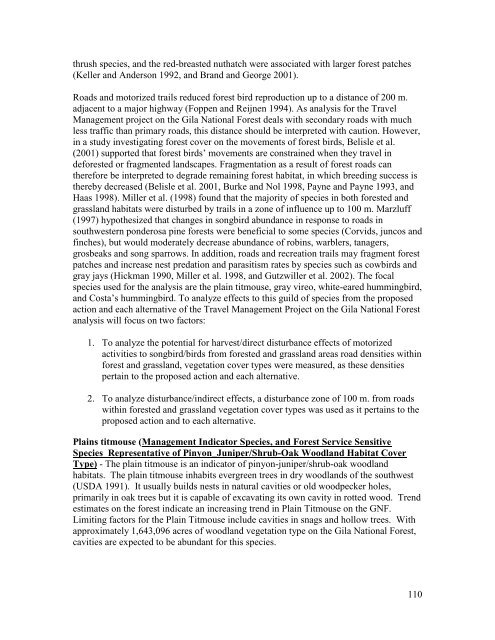Wildlife Specialist report
Wildlife Specialist report
Wildlife Specialist report
You also want an ePaper? Increase the reach of your titles
YUMPU automatically turns print PDFs into web optimized ePapers that Google loves.
thrush species, and the red-breasted nuthatch were associated with larger forest patches<br />
(Keller and Anderson 1992, and Brand and George 2001).<br />
Roads and motorized trails reduced forest bird reproduction up to a distance of 200 m.<br />
adjacent to a major highway (Foppen and Reijnen 1994). As analysis for the Travel<br />
Management project on the Gila National Forest deals with secondary roads with much<br />
less traffic than primary roads, this distance should be interpreted with caution. However,<br />
in a study investigating forest cover on the movements of forest birds, Belisle et al.<br />
(2001) supported that forest birds’ movements are constrained when they travel in<br />
deforested or fragmented landscapes. Fragmentation as a result of forest roads can<br />
therefore be interpreted to degrade remaining forest habitat, in which breeding success is<br />
thereby decreased (Belisle et al. 2001, Burke and Nol 1998, Payne and Payne 1993, and<br />
Haas 1998). Miller et al. (1998) found that the majority of species in both forested and<br />
grassland habitats were disturbed by trails in a zone of influence up to 100 m. Marzluff<br />
(1997) hypothesized that changes in songbird abundance in response to roads in<br />
southwestern ponderosa pine forests were beneficial to some species (Corvids, juncos and<br />
finches), but would moderately decrease abundance of robins, warblers, tanagers,<br />
grosbeaks and song sparrows. In addition, roads and recreation trails may fragment forest<br />
patches and increase nest predation and parasitism rates by species such as cowbirds and<br />
gray jays (Hickman 1990, Miller et al. 1998, and Gutzwiller et al. 2002). The focal<br />
species used for the analysis are the plain titmouse, gray vireo, white-eared hummingbird,<br />
and Costa’s hummingbird. To analyze effects to this guild of species from the proposed<br />
action and each alternative of the Travel Management Project on the Gila National Forest<br />
analysis will focus on two factors:<br />
1. To analyze the potential for harvest/direct disturbance effects of motorized<br />
activities to songbird/birds from forested and grassland areas road densities within<br />
forest and grassland, vegetation cover types were measured, as these densities<br />
pertain to the proposed action and each alternative.<br />
2. To analyze disturbance/indirect effects, a disturbance zone of 100 m. from roads<br />
within forested and grassland vegetation cover types was used as it pertains to the<br />
proposed action and to each alternative.<br />
Plains titmouse (Management Indicator Species, and Forest Service Sensitive<br />
Species Representative of Pinyon_Juniper/Shrub-Oak Woodland Habitat Cover<br />
Type) - The plain titmouse is an indicator of pinyon-juniper/shrub-oak woodland<br />
habitats. The plain titmouse inhabits evergreen trees in dry woodlands of the southwest<br />
(USDA 1991). It usually builds nests in natural cavities or old woodpecker holes,<br />
primarily in oak trees but it is capable of excavating its own cavity in rotted wood. Trend<br />
estimates on the forest indicate an increasing trend in Plain Titmouse on the GNF.<br />
Limiting factors for the Plain Titmouse include cavities in snags and hollow trees. With<br />
approximately 1,643,096 acres of woodland vegetation type on the Gila National Forest,<br />
cavities are expected to be abundant for this species.<br />
110
















